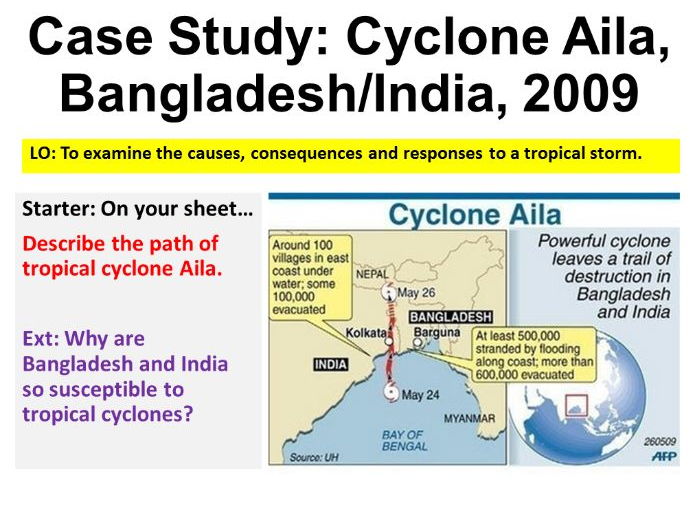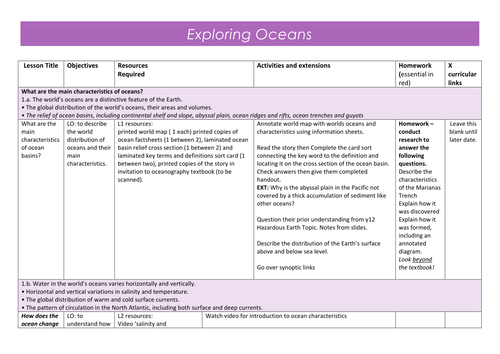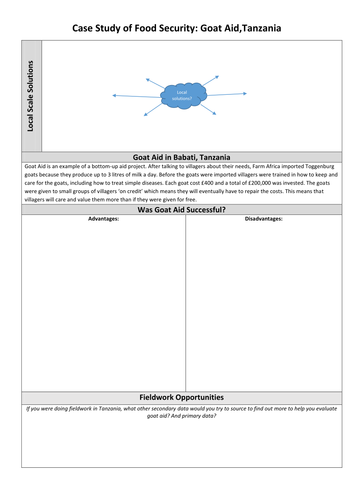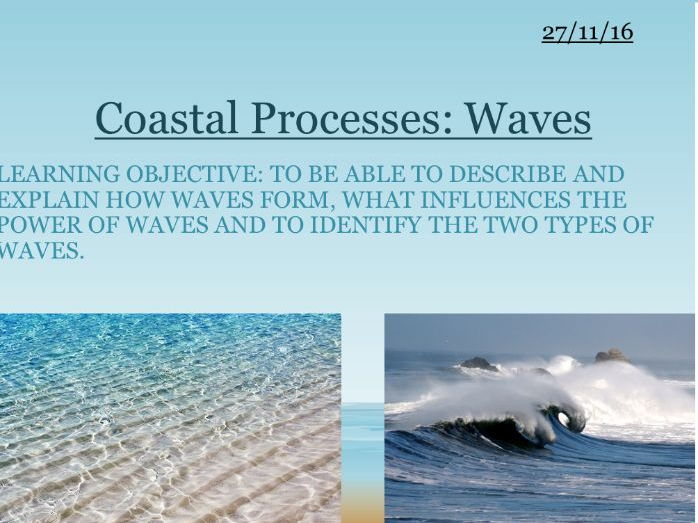
60Uploads
20k+Views
3k+Downloads
Geography

NEW OCR B A-level. Case Study of a Low Energy Coastline: New Zealand.
New OCR B A-level. Case study of a low energy coastline not in the UK. Focuses on farewell spit and golden bay in New Zealand including place specific formation of landforms, how the landscape system is inter-related and how these landforms change over time. Aimed at higher ability year 12/13 but easily adaptable for less able pupils.

NEW OCR GCSE - Natural Hazards: Case Study of Cyclone Aila
Case study lesson of a tropical storm (Cyclone Aila, Bangladesh). Includes information sheets, case study cards, exam practise and powerpoint. Aimed at top grade students but easily adapted for the less able.

OCR B 2016 Exploring Oceans SoW
A full scheme of learning/work for the new 2016 OCR B A level topic 'Exploring Oceans', including detailed lesson outlines and a list of resources (and links to videos) to cover the topic. Outlines for 30 lessons in total.

Goat Aid, Tanzania Case Study Card
Case Study sheet to be filled in on Goat Aid, Tanzania and how it has influenced food security. For the Resource Reliance topic of OCR B GCSE. Used in conjunction with the Oxford textbook.

Coasts Scheme of Work (y8-9)
A detailed scheme of work for 'coasts' aimed at high ability year 8 students and therefore easily adaptable for year 9 students. Includes learning objectives, key concepts, a list of activities and potential homework to be completed for each lesson.

Landforms of Coastal Erosion: Wave cut platforms, headlands and bays
A lesson on the formation of wave cut platforms, headlands and bays. Aimed at high ability year 8 and therefore easily adaptable for year 9 students. Includes a detailed lesson plan and presentation (with detailed notes underneath each slide).

Coastal Processes: Waves
A lesson on the formation of waves, what factors effect their power and different wave types. Aimed at high ability year 8 and therefore easily adaptable for year 9. Includes a detailed lesson plan, presentation (including detailed notes per slide) and all accompanying resources needed.

Cave, Arches, Stacks and Stumps
Lesson on the formation of cave, arches, stacks and stumps. Aimed at high ability year 8 students and therefore easily adaptable for year 9. Includes a detailed lesson plan and presentation (with notes underneath each slide).

Coastal Processes: Transportation and Deposition
Lesson on the processes of transportation and deposition at the coastline. Aimed at high ability year 8 students and therefore easily adaptable for year 9. Includes a detailed lesson plan and presentation (with notes under slides).

Coastal Processes: Longshore Drift
A lesson on the process of longshore drift and spit formation. Aimed at high ability year 8 students and therefore easily adaptable for year 9. Includes a detailed lesson plan, presentation (with notes under slides) and any other resources needed.

Coastal Management
A lesson on why coasts should be protected and how (hard and soft engineering). Aimed at high ability year 8 students and therefore easily adaptable for year 9. Includes detailed lesson plan, presentation (with notes underneath slides) and any other resources needed.

An Introduction to Coasts
An introduction to the topic 'coasts' aimed at high ability year 8 and therefore easily adaptable for year 9. Includes a detailed lesson plan, presentation (including detailed notes per slide) and all accompanying resources needed.

Coasts Scheme of Work Lesson Bundle
Coasts scheme of work bundle including a written scheme of work, detailed lesson plans and presentations, worksheets, resources and an end of unit assessment. Aimed at high ability year 8 students and therefore easily adaptable for year 9.

Urban Growth Lesson (Setlemenet KS3)
A lesson introducing push and pull factors for settlements and exploring the idea of why settlements grow. Includes full powerpoint (with detailed notes section), lesson plan, card sort and worksheet. This is for high ability year 7 so could be easily adapted for year 8 too.

NEW OCR GCSE: Natural Hazards - Atmospheric Circulation
An introductory lesson to the topic including the tri-cellular model of atmospheric circulation. Aimed at top grade students (7/8/9) and easily adaptable for the less able.

NEW OCR GCSE - Natural Hazards - Tropical Storms
A lesson on what tropical storms are (hurricanes, typhoons, cyclones), where they are found, how they are formed and how they are measured. Includes a presentation, worksheet and homework. Aimed at top grade students but easily adaptable for the less able.

NEW OCR GCSE -Natural Hazards: Causes of drought
A lesson for the new OCR GCSE on the various causes of drought as well as looking at their change in frequency and magnitude over time. Aimed at top grade students but easily adapted for the less able. Includes worksheets and teacher answers as well as a power point.

NEW OCR GCSE - Natural Hazards: Earth's structure
Lesson on the Earth's structure including the characteristics of each layer and a continental drift based homework. Aimed at top grade students but easily adapted for the less able.

NEW OCR GCSE - Natural Hazards: Earthquakes
Lesson on how earthquakes occur and their primary and secondary effects. Aimed at top grade students but easily adapted for the less able

NEW OCR GCSE - Natural Hazards: Climate Belts
A lesson on mapping the global climate belts and investigating extreme temperature, wind and rainfall across the world. It looks at the interaction between the global circulation model and climate. Aimed at high ability students but easily adapted for the less able. Worksheet and detailed resource packs included at the end of the power point.




















